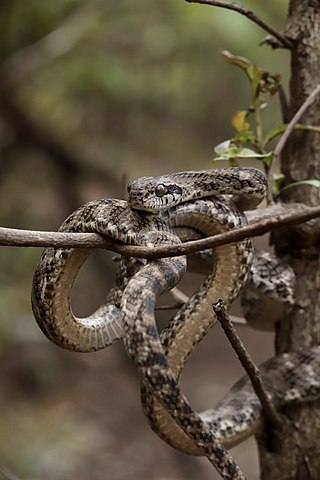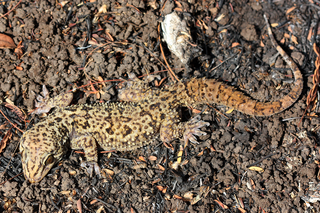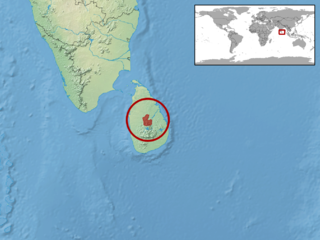
Gehyra mutilata, also known commonly as the common four-clawed gecko, Pacific gecko, stump-toed gecko, sugar gecko in Indonesia, tender-skinned house gecko, and butiki in Filipino, is a species of lizard in the family Gekkonidae. The species is native to Southeast Asia. It has made its way to several areas of the world including Sri Lanka, Indochina, and many of the Pacific Islands. Compared to the common house gecko, the appearance of G. mutilata is somewhat plump, with delicate skin. The skin is usually colored a soft purplish/pinkish gray, with golden spots on younger specimens; these spots eventually fade with age.

Monilesaurus rouxii, commonly known as Roux's forest lizard, Roux's forest calotes, or the forest blood sucker, is a species of arboreal, diurnal, agamid lizard, which is endemic to hills of peninsular India. In July 2018, it was proposed that the species should be transferred to the new genus Monilesaurus.

Boiga forsteni, also known commonly as Forsten's cat snake, is a species of mildly venomous rear-fanged snake in the family Colubridae. The species is endemic to South Asia.

Sibynophis subpunctatus, commonly known as Duméril's black-headed snake or Jerdon's many-toothed snake, is a species of nonvenomous colubrid snake endemic to Bangladesh, India, Sri Lanka, and Nepal.

The Oriental leaf-toed gecko, also known commonly as the Asian smooth gecko, Bowring's gecko, Bowring's smooth gecko, and the Sikkimese dark-spotted gecko, is a species of lizard in the family Gekkonidae. The species is native to East Asia.

Hemidactylus brookii, also known commonly as Brooke's house gecko and the spotted house gecko, is a widespread species of lizard in the family Gekkonidae.

The East Indian leopard gecko, also known commonly as Hardwicke's gecko, is a species of gecko, a lizard in the family Eublepharidae. The species is endemic to India and Bangladesh.

The Indo-Pacific gecko, also known commonly as Garnot's house gecko, fox gecko, and the Assam greyish brown gecko, is a species of lizard in the family Gekkonidae. The species is found in India, across Southeast Asia, Australia, and throughout Polynesia. Adults are about 4 to 5 in in total length. They are seen as dark gray or brown with light markings in daylight and a pale, translucent colour at night. The belly is orange or yellow. The head has a long, narrow snout, hence the name fox gecko. The flattened tail has a row of spiny scales on the lateral edges. The species is parthenogenic – all individuals are female and lay eggs that hatch without requiring male fertilisation.

The Indian golden gecko or Beddome's golden gecko is a species of gecko endemic to the Eastern Ghats of India. It was rediscovered from the hills near present-day Tirupati. The rediscovery was after over 100 years since its description.

Hemidactylus maculatus, also known as the spotted leaf-toed gecko or giant spotted gecko, is a species of large gecko found in the Western Ghats of India and in parts of Sri Lanka.
Jerdon's day gecko is a species of gecko, a lizard in the family Gekkonidae. The species is native to India and Sri Lanka.

The Kandyan day gecko or Kandyan rock gecko is a species of diurnal gecko found in Sri Lanka.
Crossobamon orientalis, commonly called the Sind gecko, is a species of gecko, a lizard in the family Gekkonidae. The species is endemic to South Asia.

The Malayan forest gecko or banded bent-toed gecko is a species of gecko found in Southeast Asia.

Lawder's bent-toed gecko is a species of gecko, a lizard in the family Gekkonidae. The species is endemic to northern India. Its type locality is "Kumaon", restricted to Almora by Malcolm Arthur Smith. It is named after Mr. A. Lawder who collected the holotype. His identity is not known for sure, but he is likely to have been A.W. Lawder who was a member of the Geological Society of London, as was Ferdinand Stoliczka who described the species. It is sometimes placed in the genus Cyrtopodion.
Hemidactylus karenorum, commonly known as the Burmese leaf gecko, the Burmese leaf-toed gecko, and the Burmese spotted gecko, is a species of gecko, a lizard in the family Gekkonidae. The species is endemic to Southeast Asia.

Hemidactylus triedrus, also known as the termite hill gecko, Dakota's leaf-toed gecko, or blotched house gecko, is a species of gecko found in South Asia. The race lankae of Sri Lanka, is now given species status and known as Hemidactylus lankae

Ophisops jerdonii, commonly known as Jerdon's cabrita, Jerdon's snake-eye, and the Punjab snake-eyed lacerta, is a species of lizard in the family Lacertidae. The species is native to South Asia.

Ophisops leschenaultii, commonly called Leschenault's snake-eye, Leschenault’s lacerta, and Leschenault's cabrita, is a species of lizard in the family Lacertidae. The species is native to India and eastern Sri Lanka. In Sri Lanka, this lizard is called pandura katussa in Sinhala. In some parts of the country, it is also called heeraluwa or sikanala, which is a common name for all skink-like reptiles.

Sphenomorphus dussumieri, commonly known as Dussumier's forest skink and Dussumier's litter skink, is a species of skink, a lizard in the family Scincidae. The species is endemic to southern India.



















